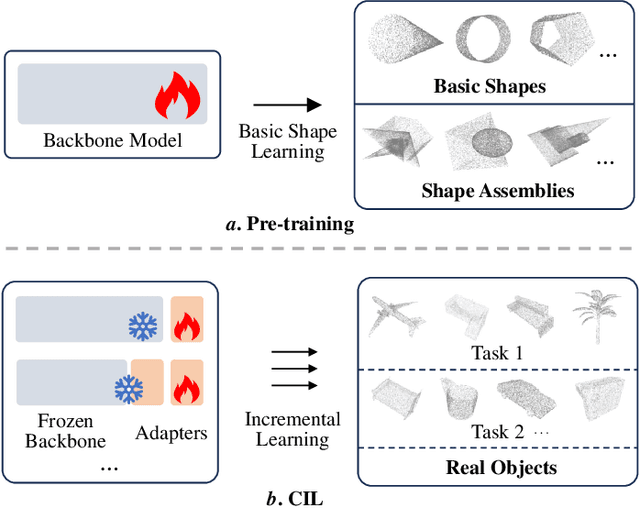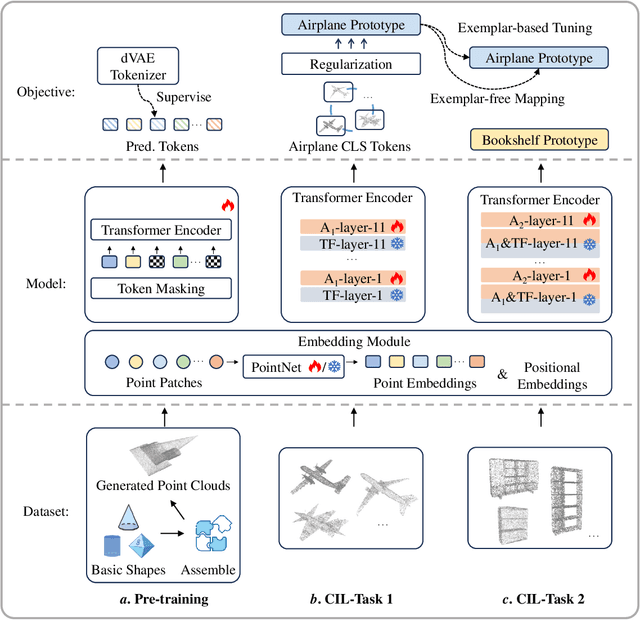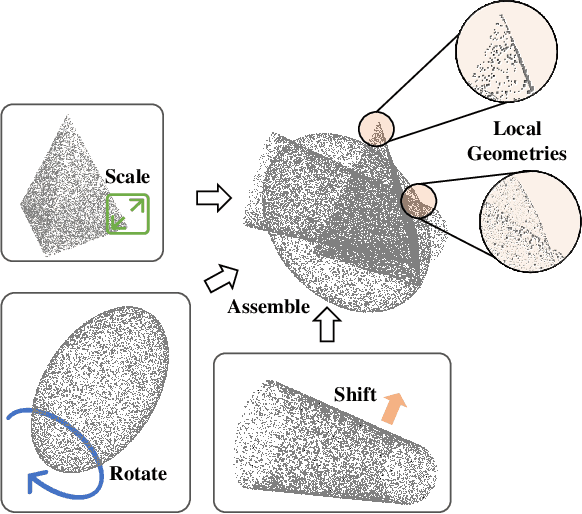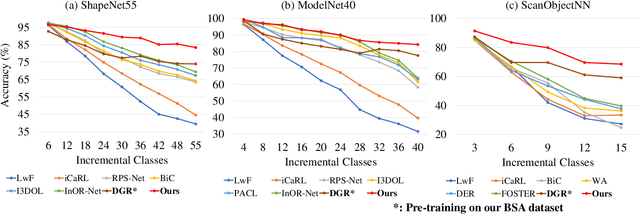Yuan Sun
FedAPM: Federated Learning via ADMM with Partial Model Personalization
Jun 05, 2025Abstract:In federated learning (FL), the assumption that datasets from different devices are independent and identically distributed (i.i.d.) often does not hold due to user differences, and the presence of various data modalities across clients makes using a single model impractical. Personalizing certain parts of the model can effectively address these issues by allowing those parts to differ across clients, while the remaining parts serve as a shared model. However, we found that partial model personalization may exacerbate client drift (each client's local model diverges from the shared model), thereby reducing the effectiveness and efficiency of FL algorithms. We propose an FL framework based on the alternating direction method of multipliers (ADMM), referred to as FedAPM, to mitigate client drift. We construct the augmented Lagrangian function by incorporating first-order and second-order proximal terms into the objective, with the second-order term providing fixed correction and the first-order term offering compensatory correction between the local and shared models. Our analysis demonstrates that FedAPM, by using explicit estimates of the Lagrange multiplier, is more stable and efficient in terms of convergence compared to other FL frameworks. We establish the global convergence of FedAPM training from arbitrary initial points to a stationary point, achieving three types of rates: constant, linear, and sublinear, under mild assumptions. We conduct experiments using four heterogeneous and multimodal datasets with different metrics to validate the performance of FedAPM. Specifically, FedAPM achieves faster and more accurate convergence, outperforming the SOTA methods with average improvements of 12.3% in test accuracy, 16.4% in F1 score, and 18.0% in AUC while requiring fewer communication rounds.
Reliable Disentanglement Multi-view Learning Against View Adversarial Attacks
May 07, 2025Abstract:Recently, trustworthy multi-view learning has attracted extensive attention because evidence learning can provide reliable uncertainty estimation to enhance the credibility of multi-view predictions. Existing trusted multi-view learning methods implicitly assume that multi-view data is secure. In practice, however, in safety-sensitive applications such as autonomous driving and security monitoring, multi-view data often faces threats from adversarial perturbations, thereby deceiving or disrupting multi-view learning models. This inevitably leads to the adversarial unreliability problem (AUP) in trusted multi-view learning. To overcome this tricky problem, we propose a novel multi-view learning framework, namely Reliable Disentanglement Multi-view Learning (RDML). Specifically, we first propose evidential disentanglement learning to decompose each view into clean and adversarial parts under the guidance of corresponding evidences, which is extracted by a pretrained evidence extractor. Then, we employ the feature recalibration module to mitigate the negative impact of adversarial perturbations and extract potential informative features from them. Finally, to further ignore the irreparable adversarial interferences, a view-level evidential attention mechanism is designed. Extensive experiments on multi-view classification tasks with adversarial attacks show that our RDML outperforms the state-of-the-art multi-view learning methods by a relatively large margin.
Robust Duality Learning for Unsupervised Visible-Infrared Person Re-Identfication
May 05, 2025Abstract:Unsupervised visible-infrared person re-identification (UVI-ReID) aims to retrieve pedestrian images across different modalities without costly annotations, but faces challenges due to the modality gap and lack of supervision. Existing methods often adopt self-training with clustering-generated pseudo-labels but implicitly assume these labels are always correct. In practice, however, this assumption fails due to inevitable pseudo-label noise, which hinders model learning. To address this, we introduce a new learning paradigm that explicitly considers Pseudo-Label Noise (PLN), characterized by three key challenges: noise overfitting, error accumulation, and noisy cluster correspondence. To this end, we propose a novel Robust Duality Learning framework (RoDE) for UVI-ReID to mitigate the effects of noisy pseudo-labels. First, to combat noise overfitting, a Robust Adaptive Learning mechanism (RAL) is proposed to dynamically emphasize clean samples while down-weighting noisy ones. Second, to alleviate error accumulation-where the model reinforces its own mistakes-RoDE employs dual distinct models that are alternately trained using pseudo-labels from each other, encouraging diversity and preventing collapse. However, this dual-model strategy introduces misalignment between clusters across models and modalities, creating noisy cluster correspondence. To resolve this, we introduce Cluster Consistency Matching (CCM), which aligns clusters across models and modalities by measuring cross-cluster similarity. Extensive experiments on three benchmarks demonstrate the effectiveness of RoDE.
Boosting the Class-Incremental Learning in 3D Point Clouds via Zero-Collection-Cost Basic Shape Pre-Training
Apr 11, 2025



Abstract:Existing class-incremental learning methods in 3D point clouds rely on exemplars (samples of former classes) to resist the catastrophic forgetting of models, and exemplar-free settings will greatly degrade the performance. For exemplar-free incremental learning, the pre-trained model methods have achieved state-of-the-art results in 2D domains. However, these methods cannot be migrated to the 3D domains due to the limited pre-training datasets and insufficient focus on fine-grained geometric details. This paper breaks through these limitations, proposing a basic shape dataset with zero collection cost for model pre-training. It helps a model obtain extensive knowledge of 3D geometries. Based on this, we propose a framework embedded with 3D geometry knowledge for incremental learning in point clouds, compatible with exemplar-free (-based) settings. In the incremental stage, the geometry knowledge is extended to represent objects in point clouds. The class prototype is calculated by regularizing the data representation with the same category and is kept adjusting in the learning process. It helps the model remember the shape features of different categories. Experiments show that our method outperforms other baseline methods by a large margin on various benchmark datasets, considering both exemplar-free (-based) settings.
MambaFlow: A Mamba-Centric Architecture for End-to-End Optical Flow Estimation
Mar 10, 2025Abstract:Optical flow estimation based on deep learning, particularly the recently proposed top-performing methods that incorporate the Transformer, has demonstrated impressive performance, due to the Transformer's powerful global modeling capabilities. However, the quadratic computational complexity of attention mechanism in the Transformers results in time-consuming training and inference. To alleviate these issues, we propose a novel MambaFlow framework that leverages the high accuracy and efficiency of Mamba architecture to capture features with local correlation while preserving its global information, achieving remarkable performance. To the best of our knowledge, the proposed method is the first Mamba-centric architecture for end-to-end optical flow estimation. It comprises two primary contributed components, both of which are Mamba-centric: a feature enhancement Mamba (FEM) module designed to optimize feature representation quality and a flow propagation Mamba (FPM) module engineered to address occlusion issues by facilitate effective flow information dissemination. Extensive experiments demonstrate that our approach achieves state-of-the-art results, despite encountering occluded regions. On the Sintel benchmark, MambaFlow achieves an EPE all of 1.60, surpassing the leading 1.74 of GMFlow. Additionally, MambaFlow significantly improves inference speed with a runtime of 0.113 seconds, making it 18% faster than GMFlow. The source code will be made publicly available upon acceptance of the paper.
A fast convergence algorithm based on binary integer programming for expert load balancing in MoE LLMs
Feb 21, 2025Abstract:MoE (Mixture-of-Expert) architectures appear frequently in large language models, and the number of experts can be over one hundred recently. However, the expert load imbalance problem always happens in MoE model pre-training, which will cause routing collapse or increased computational overhead. In order to balance loads on experts, we propose BIP-Based Balancing, an expert load balancing algorithm based on binary integer programming (BIP). The algorithm maintains an additional vector q that can help change the top-K order of s by solving a binary integer programming with very small time costs. In simulation experiments, we observe that BIP-Based Balancing make imbalance disappoint very fast, while the final sum of routine scores decreases very little. Our algorithm achieves nearly perfect trade-off between expert load balance and pre-training efficiency under the simulation view.
Robust Self-Paced Hashing for Cross-Modal Retrieval with Noisy Labels
Jan 03, 2025



Abstract:Cross-modal hashing (CMH) has appeared as a popular technique for cross-modal retrieval due to its low storage cost and high computational efficiency in large-scale data. Most existing methods implicitly assume that multi-modal data is correctly labeled, which is expensive and even unattainable due to the inevitable imperfect annotations (i.e., noisy labels) in real-world scenarios. Inspired by human cognitive learning, a few methods introduce self-paced learning (SPL) to gradually train the model from easy to hard samples, which is often used to mitigate the effects of feature noise or outliers. It is a less-touched problem that how to utilize SPL to alleviate the misleading of noisy labels on the hash model. To tackle this problem, we propose a new cognitive cross-modal retrieval method called Robust Self-paced Hashing with Noisy Labels (RSHNL), which can mimic the human cognitive process to identify the noise while embracing robustness against noisy labels. Specifically, we first propose a contrastive hashing learning (CHL) scheme to improve multi-modal consistency, thereby reducing the inherent semantic gap. Afterward, we propose center aggregation learning (CAL) to mitigate the intra-class variations. Finally, we propose Noise-tolerance Self-paced Hashing (NSH) that dynamically estimates the learning difficulty for each instance and distinguishes noisy labels through the difficulty level. For all estimated clean pairs, we further adopt a self-paced regularizer to gradually learn hash codes from easy to hard. Extensive experiments demonstrate that the proposed RSHNL performs remarkably well over the state-of-the-art CMH methods.
TPCH: Tensor-interacted Projection and Cooperative Hashing for Multi-view Clustering
Dec 25, 2024Abstract:In recent years, anchor and hash-based multi-view clustering methods have gained attention for their efficiency and simplicity in handling large-scale data. However, existing methods often overlook the interactions among multi-view data and higher-order cooperative relationships during projection, negatively impacting the quality of hash representation in low-dimensional spaces, clustering performance, and sensitivity to noise. To address this issue, we propose a novel approach named Tensor-Interacted Projection and Cooperative Hashing for Multi-View Clustering(TPCH). TPCH stacks multiple projection matrices into a tensor, taking into account the synergies and communications during the projection process. By capturing higher-order multi-view information through dual projection and Hamming space, TPCH employs an enhanced tensor nuclear norm to learn more compact and distinguishable hash representations, promoting communication within and between views. Experimental results demonstrate that this refined method significantly outperforms state-of-the-art methods in clustering on five large-scale multi-view datasets. Moreover, in terms of CPU time, TPCH achieves substantial acceleration compared to the most advanced current methods. The code is available at \textcolor{red}{\url{https://github.com/jankin-wang/TPCH}}.
Nationality, Race, and Ethnicity Biases in and Consequences of Detecting AI-Generated Self-Presentations
Dec 24, 2024Abstract:This study builds on person perception and human AI interaction (HAII) theories to investigate how content and source cues, specifically race, ethnicity, and nationality, affect judgments of AI-generated content in a high-stakes self-presentation context: college applications. Results of a pre-registered experiment with a nationally representative U.S. sample (N = 644) show that content heuristics, such as linguistic style, played a dominant role in AI detection. Source heuristics, such as nationality, also emerged as a significant factor, with international students more likely to be perceived as using AI, especially when their statements included AI-sounding features. Interestingly, Asian and Hispanic applicants were more likely to be judged as AI users when labeled as domestic students, suggesting interactions between racial stereotypes and AI detection. AI attribution led to lower perceptions of personal statement quality and authenticity, as well as negative evaluations of the applicant's competence, sociability, morality, and future success.
Human-in-the-Loop Generation of Adversarial Texts: A Case Study on Tibetan Script
Dec 17, 2024



Abstract:DNN-based language models perform excellently on various tasks, but even SOTA LLMs are susceptible to textual adversarial attacks. Adversarial texts play crucial roles in multiple subfields of NLP. However, current research has the following issues. (1) Most textual adversarial attack methods target rich-resourced languages. How do we generate adversarial texts for less-studied languages? (2) Most textual adversarial attack methods are prone to generating invalid or ambiguous adversarial texts. How do we construct high-quality adversarial robustness benchmarks? (3) New language models may be immune to part of previously generated adversarial texts. How do we update adversarial robustness benchmarks? To address the above issues, we introduce HITL-GAT, a system based on a general approach to human-in-the-loop generation of adversarial texts. HITL-GAT contains four stages in one pipeline: victim model construction, adversarial example generation, high-quality benchmark construction, and adversarial robustness evaluation. Additionally, we utilize HITL-GAT to make a case study on Tibetan script which can be a reference for the adversarial research of other less-studied languages.
 Add to Chrome
Add to Chrome Add to Firefox
Add to Firefox Add to Edge
Add to Edge